Chapter 16 Spanish Merino Sheep
When we bought Rushy Lagoon we inherited thousands of sheep, and with them a lot of worm problems. We have improved them, but have a long way to go before we can say they are perfectly healthy, though now, in 1990, we are proud of their fine condition.
While our improved water supply enables us to give them green feed all the year, this does not help the worm problem much, because sheep are prone to get more worms from lush green feed than from dry feed.
Some people in other parts of Australia and Tasmania have an easier time running Merino sheep than we do, as their areas are a little drier than ours, but we can still produce very good sheep and very good wool. However, it is a little more difficult, although we have the advantage of a plentiful supply of running water: Spanish Merinos thrive on running water.
Mostly, if the genetic base is somewhere about the same, rams born on the property are far better than those imported. They are used to the climate and conditions, and do perform better.
We have developed a nucleus flock, using 1000 of the best of our ewes, and we fleece-weigh them and test them for the desired micron we need.
We think that in our area about 21 microns is quite good, although some of our weaners may get down to 18 microns. We don't think we could get them too fine, because our area is a little too damp, and we could have a problem. Nevertheless, we may change our mind and gradually reduce them yet.
But by selecting the best nucleus ewes, and every year taking the best ones from the lambs and replacing 50 per cent of the worst of the nucleus flock, we can build up a really good flock, because we have 20,000 ewes to work on, giving us a big genetic pool.
We have been buying rams from the mainland, having joined an Australian Merino Society wool plan under which we send some of our best ewes to the central section. We sent ours to Seymour, and we were in 1988 the only ones in Tasmania to join this wool plan. We send our pick ewes there and they allow us to have about 10 pick rams. We managed to get some in 1989, although we had only just joined.
We soon received orders from New Zealand for 110 of our ewes which we produced in 1987-88, and received increased enquiries for the following years. They were really replacements from the nucleus flock, but were still very good ewes. I think we have a great future in the ewe and ram sales because of our genetic testing and print outs.
Our nucleus flock increased production by five per cent this year. That is a fantastic amount when our wool cheque exceeds a million and a half dollars a year. If you get an increase of one per cent it is good.
Since we established the nucleus flock of 1000 Spanish Merino ewes to breed our own rams and improve our 50,000 Spanish Merino sheep, generally there has been a marked improvement in the flock. In 1989 the Australian Merino Society voted us into the A.M.S. As well as being the first in the State, we were the only financial members of Merinotech, which is a company formed by the A.M.S. and the University of New England for genetic breeding and improvement of Merinos.
On March 16, 1989, the Federal President of the A.M.S. referred to our contribution as 'magnificent dense white-woolled ewes from Berts Farquhar's Rushy Lagoon property in Tasmania.'
I had one advantage when we bought Rushy Lagoon in that I did
not really know anything about sheep. I had to really learn and, of
course, my staff are terrific. I still have a lot to learn, as I remarked to
a reporter. When I was asked did I know much about sheep, I replied,
Yes, what I know would fill a book, but what I don't know would fill
a library
. This was true when we bought Rushy Lagoon with its
40,000-odd Spanish Merino sheep. After touring the State, New
Zealand buyers, as mentioned, bought our nucleus ewes and rams.
They were not only pleased with their purchases, but are now very
pleased with their offspring, so increased future sales are assured.
We feel very confident that we can not only increase the numbers of our sheep, but productivity in every way. This augurs well for our sheep industry which still has a good long-term future.
Also the progeny testing, breeding objective, micron-sampling and general research has proven that our own produced rams are superior to most of those imported, thereby greatly increasing the performance of our own flocks.
We are not only breeding our own rams, but also our own Hereford and Angus bulls, for we consider that bulls or rams bred on the property are the best animals, provided genetic aspects are correct.
It is a very big job to look after 50,000 sheep. It does take a tremendous amount of planning and understanding to look after so many sheep efficiently. Rodney Moore and his staff on the sheep are doing an excellent job. Nothing seems to 'rattle' them and it certainly makes life easy for everyone.
When you have a good showery autumn and get plenty of feed, there are then plenty of blow flies about. When you get a windy day and the cattle won't drive, the flies then don't worry the sheep so much.
We get a contract shearing team over from Victoria (Ken Paulke's team) to shear our 50,000 odd sheep and lambs. It takes the team of 36, including cooks, rouse-abouts, classers, shearers and others about five weeks to shear all the sheep.
We have under-cover facilities to cater for about 4,000 to 4,500 sheep, because sheep cannot be shorn when wet.
It is wonderful to watch the foreman with his watch starting the shearers at 7.30 a.m. No one starts asecond early and no one continues (apart from finishing his sheep) when the lunch whistle blows. The penner-up chap runs along the piping fencing, whistling his dogs, working and pushing the sheep into the pen. The cook, paid by the contractor, charges for three meals and two lunches, the cost of the food about $3.20 to $3.80 per day. It seems amazingly cheap for the lovely meals provided, but then the meat is supplied on the award, at 12 cents a lb., all mutton. The accommodation caters for 43 shearers and offsiders and we keep it really clean and good for them. They are a terrific lot of people.
Sometimes they have one or two girls in the team and this presents no problems. Actually I think it is always good to have a mixture of the sexes; it seems to help everyone. Similarly I think that co-educational schools are better than single sex schools, but others may differ on this.
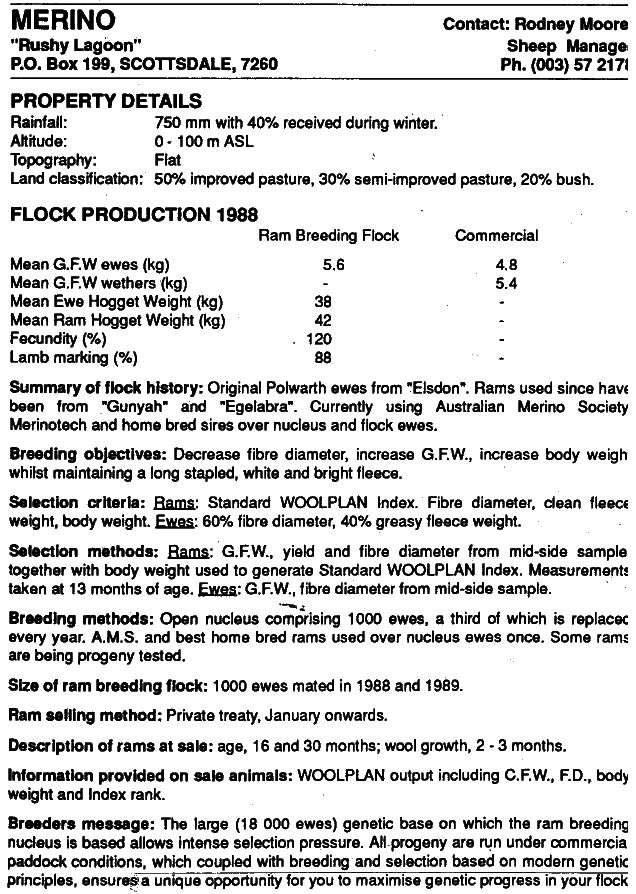
Extract from 'Rampower' which gives the reader a better knowledge
of what we are doing with our ram breeding programme.
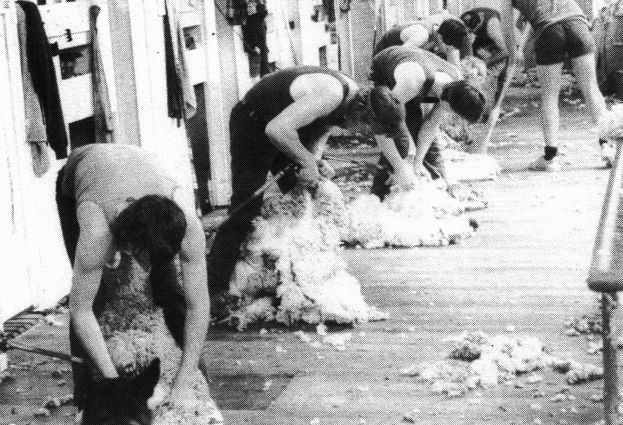
Ken Paulke's shearing gang, shearing approximately 50,000 sheep in 1988.
It takes a full gang five weeks of about 36 shearers, cooks, rouseabouts and shed hands to pen,
shear and class and bale wool of 1,200 odd bales.
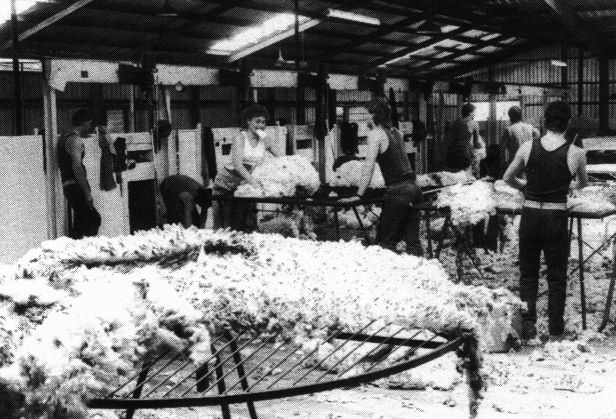
Classing wool.
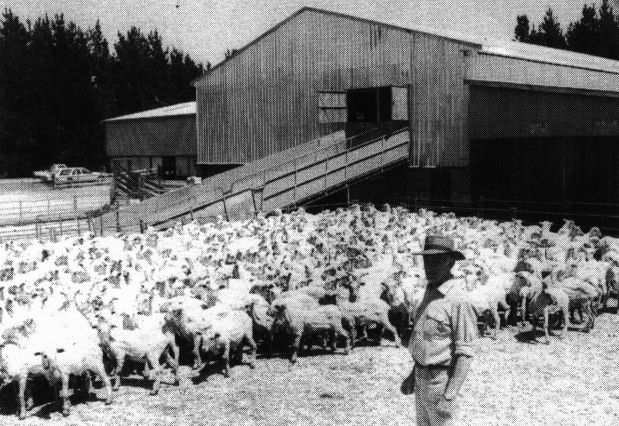
Viewing some of our 50,000 odd Spanish Merino sheep.
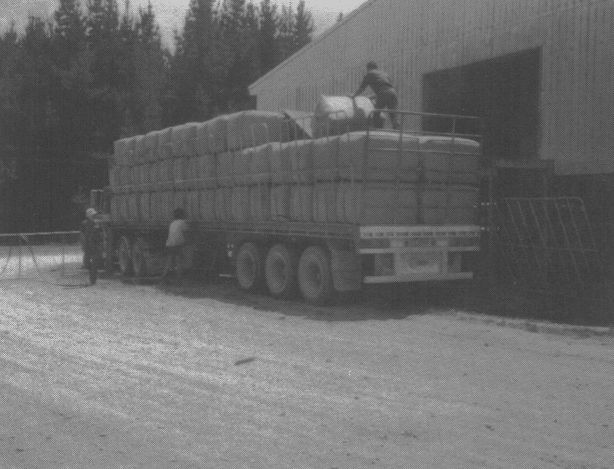
Loading of wool. Part of consignment of 1,200 bales being sent direct to Melbourne.